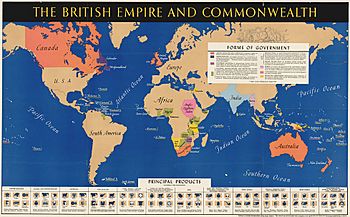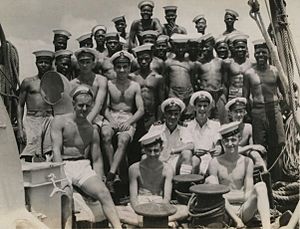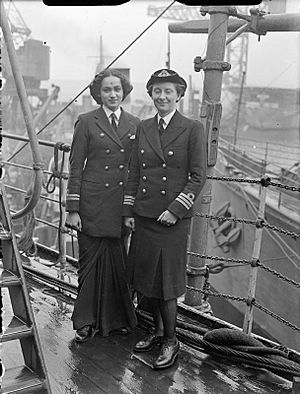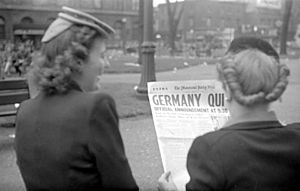British Empire in World War II facts for kids
When the United Kingdom declared war on Nazi Germany in September 1939, marking the start of World War II, it was a huge global power. The UK controlled many colonies, protectorates, and India. It also had special ties with four independent countries: Australia, Canada, South Africa, and New Zealand. These countries, along with the UK, were part of the "British Commonwealth". In 1939, the British Empire and Commonwealth together controlled about 25% of the world's people and 30% of its land.
The help from the British Empire and Commonwealth was super important for the Allied war effort. From 1939 to mid-1942, the UK led Allied efforts in many parts of the world. Forces from the Commonwealth, colonies, and Imperial India totaled nearly 15 million people. They fought against the German, Italian, and Japanese armies, air forces, and navies. These battles happened across Europe, Africa, Asia, and in many oceans. Commonwealth air forces even fought the Luftwaffe (German air force) to a standstill over Britain. Commonwealth armies also defeated Italian forces in East Africa and North Africa.
The Commonwealth held back or slowed the Axis powers for three years. During this time, it built up a massive military and industrial system. By 1942, it was the largest military setup of the war. This effort came with a high cost: 150,000 military deaths and many more wounded or captured. Over 300,000 civilians also died. The Commonwealth also lost many warships, submarines, aircraft, and vehicles. After the United States joined the war in December 1941, the Commonwealth and the US worked together globally. As the US military grew, it took command in many areas, freeing up Commonwealth forces for other duties. Cooperation with the Soviet Union also grew. However, it was hard to defend far-off colonies from attacks by the Axis powers at the same time.
Even though the British Empire and Commonwealth countries won the war with the USA, the USSR, and other Allies, World War II showed that Britain was no longer the strongest world power. The United States had become more powerful. Japan's successes in Asia also damaged Britain's image of strength there. This, along with a strong desire for independence, led to decolonisation in the years that followed.
Contents
- How Britain Planned for Defence
- When War Was Declared Against Germany
- How the Empire and Commonwealth Helped
- Crisis in the Mediterranean Sea
- The Fall of Singapore
- Africa's Role in the War
- India's Contribution
- Victory and Its Aftermath
- What Happened After the War
- How Historians See It
- Military Histories of British Territories
- See also
How Britain Planned for Defence
From 1923, Britain's plan to defend its colonies in East Asia and Southeast Asia was called the "Singapore strategy". This plan assumed Britain could send a navy fleet to its base in Singapore quickly if Japan attacked. It also relied on France to help in Asia and defend British areas in the Mediterranean. However, the planners didn't expect France to fall to Germany. When Nazi Germany occupied France, it threatened Britain directly. This forced Britain to completely rethink its naval defence plans.
In the 1930s, three threats appeared for the British Commonwealth: strong military governments in Germany, Italy, and Japan. Germany threatened Britain itself. Italy and Japan wanted to expand their empires, which would clash with Britain's presence in the Mediterranean and East Asia. But there were different ideas within the UK and its Dominions about which threat was most serious. They also wondered if all three powers would attack at the same time.
When War Was Declared Against Germany

On September 1, 1939, Germany invaded Poland. Two days later, on September 3, Britain and France declared war on Germany. This happened after Germany ignored Britain's demand to stop its military actions. Britain's declaration automatically meant that India, the Crown colonies, and the protectorates were also at war. However, the Statute of Westminster of 1931 gave the Dominions (like Canada and Australia) the power to decide for themselves.
Australian Prime Minister Robert Menzies immediately joined Britain's declaration on September 3. New Zealand followed at the same time. South Africa took three days to decide, on September 6. Their Prime Minister, General J. B. M. Hertzog, wanted to stay neutral. But he was outvoted by those who wanted war, led by General Jan Smuts, who then became Prime Minister. Canadian Prime Minister Mackenzie King supported Britain on the day of the British declaration. But he said that Parliament needed to make the official declaration, which it did a week later on September 10. Ireland, though still part of the Commonwealth, chose to stay neutral throughout the war.
How the Empire and Commonwealth Helped
Resources were quickly gathered, and fighting began almost right away. Just hours after Australia declared war, a gun at Fort Queenscliff fired a warning shot at a ship trying to leave Melbourne without permission. On October 10, 1939, an aircraft from No. 10 Squadron RAAF based in England became the first Commonwealth air force unit to see action. It flew a mission to Tunisia.
The first Canadian convoy of 15 ships carrying war supplies left Halifax just six days after Canada declared war. By January 1, 1940, Canada had sent an entire division to Britain. In June 1940, Canadian troops went to France to help protect the British forces in Belgium. As France was about to fall, Britain asked Canada for more troops in North America, the Atlantic, and the Caribbean. Canada sent troops to help defend British Caribbean colonies and the colony of Newfoundland. Canada also occupied Iceland from June 1940 to spring 1941, after Britain's first invasion.
From mid-June 1940, after Germany quickly invaded and occupied many European countries, the British Commonwealth was the main opponent of Germany and the Axis. This lasted until the Soviet Union joined the war in June 1941. During this time, Australia, India, New Zealand, and South Africa sent many ships and divisions to defend the Mediterranean, Greece, and Egypt. There, British troops were greatly outnumbered by Italian armies. Canada sent another 2nd Canadian Infantry Division, pilots, and warships to Britain to face a possible German invasion.
In December 1941, Japan launched quick attacks on British Malaya, the US naval base at Pearl Harbor, and Hong Kong.
Canada gave a lot of money to the UK and other Commonwealth countries. This was over $4 billion in aid through programs like the Billion Dollar Gift and Mutual Aid. During the war, over 1.6 million Canadians served in uniform. By the end of the war, Canada had the third-largest navy and fourth-largest air force in the world. Almost a million Australians also served in the armed forces. Their units fought mainly in Europe, North Africa, and the South West Pacific.
The British Commonwealth Air Training Plan was set up by Australia, Canada, New Zealand, and the UK. This plan involved:
- Joint training at flight schools in Canada, South Africa, Australia, and New Zealand.
- Forming new squadrons (groups of aircraft) from Dominion air forces. These were called "Article XV squadrons" and served with the Royal Air Force.
- Mixing RAF and Dominion air force personnel, who served in both RAF and Article XV squadrons.
Money Matters During the War
Britain borrowed money from everywhere it could. It bought a lot of weapons and supplies from India and Canada, as well as other parts of the Empire and neutral countries. Canada also gave gifts of money. By 1945, Britain owed about £3.4 billion (which is like $200 billion today) to countries in its Sterling Area. Britain treated this as a long-term loan with no interest. The British treasury was almost empty by 1945.
Crisis in the Mediterranean Sea
In June 1940, France surrendered to German forces. Italy then joined the war on the Axis side. This changed Britain's Singapore strategy. Winston Churchill, who had become British Prime Minister, decided that the Middle East and the Mediterranean were more important to defend than the Far East.
Commonwealth forces played a big role in North and East Africa after Italy joined the war. They helped invade Italian Libya and Somaliland. But they had to retreat after Churchill sent resources to Greece and Crete.
The Fall of Singapore
The Battle of Singapore was a major fight in the South-East Asian part of World War II. It happened when the Japanese Empire invaded British Malaya and its strong base of Singapore. Singapore was Britain's main military base in South East Asia and was called the ""Gibraltar of the East"". The fighting in Singapore lasted from January 31 to February 15, 1942. It followed a terrible naval battle in December 1941 where two large British warships were sunk.
The battle ended with the fall of Singapore to the Japanese. It was the largest surrender of British-led military people in history. About 80,000 British, Australian, and Indian troops became prisoners of war. This was in addition to 50,000 taken by the Japanese in the Malayan campaign. British Prime Minister Winston Churchill called the fall of Singapore the "worst disaster" and "largest surrender" in British history.
Africa's Role in the War
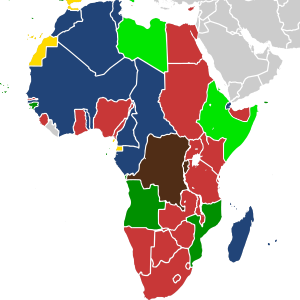
Africa was a huge continent that was very important strategically during the war. North Africa was where a major campaign against Italy and Germany took place. This included battles in El Alamein and Tobruk. East Africa also saw a big campaign against Italy. This led to the liberation of Somalia, Eritrea, and Ethiopia, which Italy had conquered in 1936.
Africa's vast size provided important transport routes. Supplies for Russia often came this way, even though it added 40 days to journeys. Inside Africa, long roads and railroads helped the British war effort. The Union of South Africa was part of the British Commonwealth of Nations and had been independent since 1931. British areas in Africa were ruled by the colonial office, often working closely with local leaders. The British controlled the richest parts of Africa. They used its land, people, and natural resources a lot. Colonial officials worked to improve Africa's infrastructure, promote farming, and recruit over half a million soldiers.
Before the war, Britain had few plans for using Africa. But it quickly set up military commands. The Army created the West Africa Command, which recruited 200,000 soldiers. The East Africa Command was made in September 1941 to help the busy Middle East Command. The Royal Navy set up the South Atlantic Command in Sierra Leone, which became a main meeting point for convoys. The RAF (Royal Air Force) also had major submarine-hunting operations based in West Africa.
Before the war, military groups in British Africa were very small and mostly made up of white people. As soon as the war started, new African units were created, mainly by the Army. These new recruits were almost always volunteers, often with the help of local tribal leaders. During the war, military pay was much better than what civilians could earn. The largest number of recruits were in construction units, with over 82,000 soldiers. East Africa provided the most men, over 320,000, mostly from Kenya, Tanganyika, and Uganda. They did some fighting, a lot of guard duty, and construction work. 80,000 served in the Middle East. The soldiers were trained to European standards and learned leadership skills. These skills later helped in the movements for independence after 1945.
India's Contribution
The Viceroy Linlithgow declared that India was at war with Germany without asking Indian politicians.
There was serious disagreement over American support for India's independence. Churchill strongly disagreed with this idea. The Indian population was very divided. Some wanted the British out so much that they sided with Germany and Japan. They formed the Indian National Army (INA) from Indian prisoners of war. This army fought with the Japanese in Burma and eastern India. Many Indians were also pacifists, meaning they were against all violence. They followed Gandhi's call to stay out of the war.
There was also a lot of religious tension between the Hindu majority and the Muslim minority. For the first time, the Muslim community became very active in politics. They strongly supported the British war effort. Over 2 million Indians volunteered for military service, including many Muslims. The British listened to the demands of the Muslim League, led by Muhammad Ali Jinnah. This was because Britain needed Muslim soldiers in India and Muslim support across the Middle East. London used the religious tensions in India as a reason to keep ruling, saying it was needed to prevent religious violence.
The British government sent Sir Stafford Cripps to India with a peace plan. It offered India the promise of self-rule after the war. But the Congress Party demanded independence right away, and the mission failed. In 1942, when the Congress Party started a Quit India Movement of peaceful protest, the police immediately arrested tens of thousands of activists, including Gandhi. They were held for the rest of the war.
Meanwhile, the war caused severe food shortages in eastern India. Hundreds of thousands of people died from starvation. Many Indians still blame Churchill for the Bengal famine of 1943. For the war effort, India became a major base for American supplies sent to China. The 2 million Indian soldiers were a big reason for British success in the Middle East. Muslim support for the British war effort was key to Britain's decision to divide India, creating the new state of Pakistan.
Victory and Its Aftermath
On May 8, 1945, the World War II Allies officially accepted the unconditional surrender of Nazi Germany's armed forces. This marked the end of Adolf Hitler's Third Reich. The official surrender of German forces in the Channel Islands was on May 9, 1945. The act of military surrender was signed on May 7 in Reims, France, and confirmed on May 8 in Berlin, Germany.
On the afternoon of August 15, 1945, Japan surrendered, effectively ending World War II. This announcement was made in Japan on August 15. Because of time differences, it was announced in the United States, Western Europe, the Americas, the Pacific Islands, and Australia/New Zealand on August 14, 1945. The actual signing of the surrender document happened on September 2, 1945.
What Happened After the War
By the end of the war in August 1945, British Commonwealth forces were in charge of many non-Commonwealth areas they had occupied. These included Eritrea, Libya, Madagascar, Iran, Iraq, Lebanon, Italian Somaliland, Syria, Thailand, and parts of Germany, Austria, and Japan. Most of these areas were soon given back to their old European colonial rulers or to new local governments. Commonwealth forces managed occupation zones in Japan, Germany, and Austria until 1955.
World War II showed that Britain was no longer the great power it once was. The United States had become the leading world power. Canada, Australia, and New Zealand began to align more with the United States. Japan's attacks had shattered the image of imperial strength in Asia, and Britain's reputation there was permanently damaged. India's entry into the war had effectively guaranteed its independence, which came within two years of the war's end. This meant Britain lost its most populated and valuable colony. The sending of 150,000 Africans overseas from British colonies, and the presence of white troops in Africa, changed how the Empire was seen in Africa.
How Historians See It
Historians have written a lot about the war in South Asia and Southeast Asia. As historian Ashley Jackson explains, many terrible things happened:
- Terror, mass migration, shortages, inflation, blackouts, air raids, massacres, famine, forced labor, growth of cities, environmental damage, occupation [by the enemy], resistance, collaboration – all of these dramatic and often horrific phenomena shaped the war experience of Britain's imperial subjects.
British historians of World War II haven't always focused on how important the Empire was. The Empire provided money, soldiers, and imported food and raw materials. This powerful combination meant Britain didn't fight Germany alone. It led a great, though fading, empire. Ashley Jackson says that the story of the British Empire's war is both a success in helping the Allies win and a failure. Britain struggled to protect its people and defeat the enemy, and it failed to win the full loyalty of its colonial subjects.
The Empire's contribution in soldiers was huge: 2.5 million men from India, over 1 million from Canada, almost 1 million from Australia, 410,000 from South Africa, and 215,000 from New Zealand. Also, the colonies provided over 500,000 uniformed people who served mainly in Africa. For money, Britain's war budget included £2.7 billion borrowed from the Empire's Sterling Area, which was eventually paid back. Canada also gave C$3 billion in gifts and easy loans.
Military Histories of British Territories
The colonies, Dominions, and protectorates of the British Empire all helped a lot in the war effort around the world. You can find more information about their involvement in the military histories of these individual places listed below.
Africa
 Ascension Island
Ascension Island Basutoland
Basutoland Bechuanaland Protectorate
Bechuanaland Protectorate British Cameroons
British Cameroons Gambia
Gambia Gold Coast
Gold Coast Kenya
Kenya Mauritius
Mauritius Nigeria
Nigeria Northern Rhodesia
Northern Rhodesia Nyasaland
Nyasaland Category:Saint Helena and Dependencies in World War II
Category:Saint Helena and Dependencies in World War II Seychelles
Seychelles Sierra Leone
Sierra Leone Somaliland
Somaliland South Africa
South Africa
 Southern Rhodesia
Southern Rhodesia Anglo-Egyptian Sudan
Anglo-Egyptian Sudan Swaziland Protectorate
Swaziland Protectorate Tanganyika
Tanganyika Togoland
Togoland Uganda
Uganda Zanzibar
Zanzibar
Americas
 Bahamas
Bahamas Barbados
Barbados Bermuda
Bermuda Canada
Canada Cayman Islands
Cayman Islands Falkland Islands
Falkland Islands British Guiana
British Guiana British Honduras
British Honduras Jamaica
Jamaica Leeward Islands
Leeward Islands Newfoundland
Newfoundland Trinidad and Tobago
Trinidad and Tobago Turks and Caicos
Turks and Caicos Windward Islands
Windward Islands
East Asia
Europe
Middle East
 Category:Aden in World War II
Category:Aden in World War II Bahrain Protectorate
Bahrain Protectorate Egypt
Egypt Kuwait Protectorate
Kuwait Protectorate Mandatory Palestine
Mandatory Palestine Qatar Protectorate
Qatar Protectorate Transjordan
Transjordan Trucial States
Trucial States
Oceania
 Australia
Australia
 Fiji
Fiji Gilbert and Ellice Islands
Gilbert and Ellice Islands Nauru
Nauru New Hebrides
New Hebrides New Zealand
New Zealand
 Western Samoa
Western Samoa
 Pitcairn Islands
Pitcairn Islands Solomon Islands
Solomon Islands Tonga Protectorate
Tonga Protectorate
South Asia
 Ceylon
Ceylon India
India Maldives Protectorate
Maldives Protectorate
Southeast Asia
 Brunei Protectorate
Brunei Protectorate Burma
Burma Malaya
Malaya North Borneo
North Borneo Sarawak
Sarawak Straits Settlements
Straits Settlements
See also
- Diplomatic history of World War II
- Historiography of the British Empire
- Military history of the United Kingdom during World War II
Homefront Efforts
- Australian home front during World War II
- Christmas Island Mutiny and Battle
- Gibraltar evacuation in the Second World War
- British home front during the Second World War
- Japanese occupation of the Andaman Islands
- Japanese occupation of British Borneo
- Japanese occupation of Nauru
- Japanese occupation of Singapore
Major Military Groups and Units
- List of British Empire corps of the Second World War
- List of British Empire divisions in the Second World War
- List of British Empire brigades of the Second World War
- East Africa Command
- Far East Command
- India Command
- Malaya Command
- Middle East Command
- Persia and Iraq Command
- West Africa Command
- Pacific Fleet
- Eastern Fleet
- Home Fleet
- Mediterranean Fleet
- Reserve Fleet
- Bomber Command
- Ferry Command
- Fighter Command
- RAF Squadrons
- British Commonwealth Air Training Plan
- British Commonwealth Occupation Force



